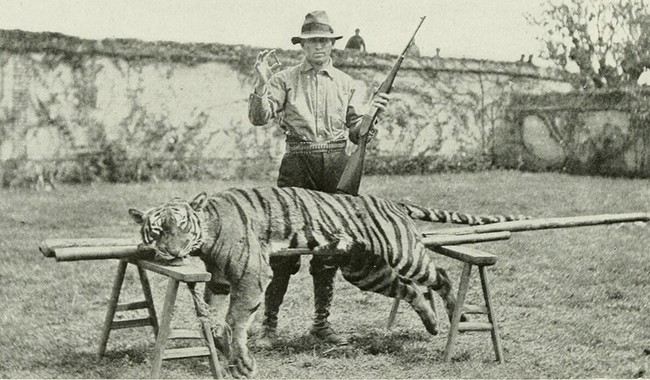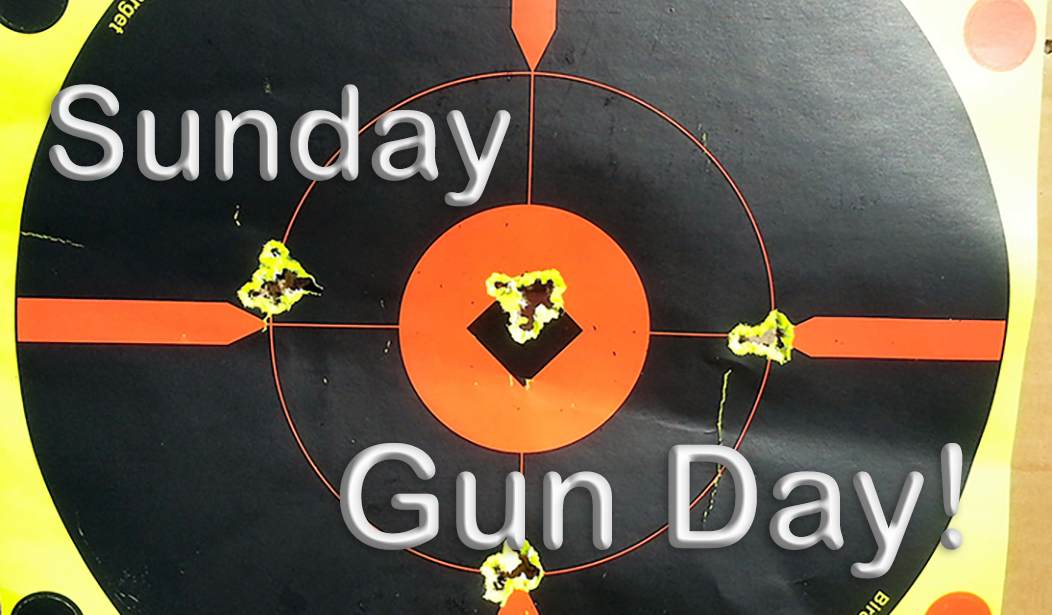The Velocity Race
When I was a kid just learning the shooting sports in the Seventies, all the major rifle manufacturers, ammo companies, and wildcatters were not yet worried about the upcoming “weapons of war” screechers, but they were engaged in a race for velocity. Roy Weatherby contributed heavily with his proprietary line of 3,000fps+ rifle cartridges, but he wasn’t alone, and he wasn't the first. The gun companies were daily bringing out new variations on the Eargesplitten Loudenboom Magnum with muzzle velocities approaching relativistic speeds. The trend continued into the next couple of decades; back in the Nineties, when I was running a little email newsletter on Mauser bolt guns, one of my regular readers used to regale us with tales of his wildcatter buddies Aimo and Delbert. Those worthies once supposedly came up with a .17/50BMG wildcat, which had a muzzle velocity so high that the bullet arrived on target before the shooter even uncased the rifle.
But there was one man who anticipated the trend and indeed predated them all; so much so, in fact, as to have been well ahead of his time. His name? Charles Newton.
The Man
Surprisingly little is known about Charles Newton. We know he was born in Delevan, New York, in 1868; we know he was a lawyer and firearms aficionado with an ambition to become a gunmaker. He had some pretty good ideas about big game rifles, was conversant in bolt guns, and was obviously a student of Paul Mauser’s designs.
We also know he was a couple of decades ahead of his time.
The Plan
When Newton first set out to market his own ideas in bolt-action game rifles in 1914, the American outdoor scene was dominated by lever actions. But several events were happening around the world that would change that.
First: Sixteen years earlier, Paul Mauser, working in his factory in Oberndorf am Neckar in Bavaria, created what would be the pattern for most bolt guns thereafter: The 1898 Mauser. Unlike the previous designs from Mauser-Werke, the 98 had a robust reinforcing ring in the beefier forward receiver ring; the ’98 also had a third “safety” locking lug, an improved gas shield in the bolt shroud to vent hot gases away from the shooter in the event of a case failure, and it cocked on opening, using the leverage of the bolt handle to cock the striker rather than making the shooter push the bolt closed against the striker spring.
This set the 98 apart from previous bolt guns in several ways. First, the action was tougher, allowing the use of high-pressure, high-performance cartridges. Second, the cock-on-open action made for faster, more certain cycling of the action. Third, the gas shield made the ’98 safer for the shooter in case a high-performance round blew a case head.
Second: In June of 1914, a Serb Yugoslav nationalist named Gavrilo Princip rubbed out the Austro-Hungarian royal heir Archduke Franz Ferdinand in Sarajevo, triggering a conflict that eventually exploded into the Great War. Why is this relevant to the American sporting rifle picture?
Three years later, in 1917, the United States entered that conflict. In all, 2.8 million American servicemen volunteered or were conscripted for that conflict (my grandfather was among the first group). Those who were hunters and shooters had, like most American sportsmen, favored lever guns prior to this, but their service time made them intimately familiar with the Pattern 17 Enfields and the excellent 1903 Springfield rifles they were issued; both rifles were essentially clones of the 98 Mauser. When they returned home, the American doughboys led the slow but inevitable rise of the bolt gun as the go-to American sporting rifle.
Charles Newton was poised to capitalize on that trend.
The Cartridges
A rifle is a device for launching bullets. Knowing that to be true, Newton began his forays into ammunition before he began building rifles. Of all his cutting-edge (for the time) cartridges, only his first is still in use today.
In or around 1912, Charles Newton designed a new cartridge for a company that had a great property, a cutting-edge lever gun; that company was Savage, the gun being the Model 99, and the cartridge Newton developed became the .22 Savage Hi-Power. It wasn’t a complicated piece of engineering; he merely took the .25-35 WCF case and necked it down to take an oddball .228 bullet. But the combination of high velocity and the slightly over-bore .22 round firing a 70-grain soft point bullet yielded a round that punched well outside its weight class by the standards of the time. The round became popular in Europe for hunting red deer, Europe’s slightly smaller variation on North American elk; no lesser a man than W.D.M. “Karamojo” Bell, demonstrating once again the advantages gifted by an enormous brass pair of masculine appendages, successfully used a .22 Savage Hi-Power rifle to hunt Cape buffalo. Newton’s ideas of high velocity and high penetrating power were beginning to earn some respect in the game fields.
 The .22 Savage Hi-Power, in the European guise of the 5.6x52R, is, in fact, the only one of Newton’s cartridge designs still in common use, although only in Europe – and only in those jurisdictions where the peasants are still allowed to own rifles.
The .22 Savage Hi-Power, in the European guise of the 5.6x52R, is, in fact, the only one of Newton’s cartridge designs still in common use, although only in Europe – and only in those jurisdictions where the peasants are still allowed to own rifles.
The following year, 1913, saw Newton bringing out another new cartridge. The .256 Newton was another adaptation of an existing round – Newton took the famous .30-06 case and necked it down to take a .25 caliber bullet. Sound familiar? Of course – many years later, Remington legitimized the popular wildcat round that originally came out as the .256 Newton, calling it the .25-06 Remington. For Newton, the .256 round was a breakthrough. Western Cartridge Company loaded the case with a 123-grain pill at a tad over 3100 fps, a blazing-hot round for the time.
Then, that same year, Newton brought out one of the first real magnum rifle cartridges, the .30 Newton, which fired a 150-grain bullet at over 3,200fps. This was a rip-roaring .30 caliber round for this pre-Great War market. Newton achieved this by necking down the big German 11.2x72 Schuler case. This was a big, beefy case; the original 11.2x72 (firing a .44 caliber bullet, more or less) round was a popular round in German rifles made for the African safari market at the time.
This case was roomy enough to be adapted for larger bullets, and Newton took advantage of that, bringing in the .33 and 35 Newton in 1915, launching 225 and 250-grain bullets at 2800fps, and finishing up with the .40 Newton, which never saw full production (as we’ll explore here in a moment) but which theoretically could propel a 300-grain slug at over 3,000fps.
But a cutting-edge cartridge is of little use unless you have a rifle that can handle it. It was in the development of those rifles that Newton showed his prescience.
The Guns
While a rifle may be a device for launching bullets, the bullets are nothing without the rifle; and it is in the rifle that a designer has a chance to achieve some real artistry.
The first Newton rifle wasn’t made by Newton. In 1914, the Model A Newton hit the market, sold only in the .256 Newton caliber. It’s unclear how many Model A Newtons were imported, but the number is likely under a hundred. The rifles were made under contract in Germany; one shipment of 24 rifles, built on 98 Mauser actions, is confirmed to have been received and sold by Newton. Other shipments were prepared but not sent, and it is unknown what happened to those guns, as the beginning of the Great War interfered with shipments across the Atlantic.
Undeterred, Newton decided to build his own guns. In 1916, he re-formed the Newton Arms Co., Inc. and enlisted the assistance of legendary gunsmith and barrel-maker Harry Pope. In due time, the Newton Arms Co. introduced the first American-made Newton, the First Model 1916.
This was a solid bolt gun that departed from the Mauser in having not one or two large locking lugs but six smaller ones, making for a shorter bolt throw. The 1916 was, at last, the culmination of Newton’s intentions for a modern bolt-action sporting rifle. About 4,000 were made, chambered for the .22 Savage Hi-Power, the .256, .30, .33, .35 Newton calibers, as well as the .30 U.S.G., better known nowadays as the .30-06. .40 Newton rifles were advertised, but it’s unclear if any were actually built. The 1916 also featured a variety of wood grades, barrel lengths up to thirty inches, scope mounts, and a double-set trigger.
But not all those 4,000 rifles were made by Newton.
Newton was a man ahead of his time, but his timing was poor in other respects as well. He was trying to build and market an innovative new sporting rifle while most of Western civilization was involved in a horrible war of attrition on the European continent, making it very difficult to obtain steel and components for ammunition; since Newton’s rifles used (mostly) proprietary ammo, there was no pre-war inventory to rely on. Newton was able to produce the 1916 rifles for about 16 months, building 2,400 or so rifles in that time. But then ongoing financial troubles threatened to sink the Newton Arms Company, which was forced into receivership for a little over three months; the receiver sold the company’s assets to a third party, who formed the Newton Arms Corporation in New York City and continued building the Model 1916 rifles, cranking out about 1,600 before Newton sued to get his design back. No more Model 1916 Newtons were built after that.
Still, in due time, the Great War ended. Lots of American doughboys came home, and many of them returned to their pre-war pastimes, which included hunting and shooting; suddenly, there was a market for bolt-action sporting rifles. Such firms as Remington and Winchester were already stepping into the market, and so in 1922, Charles Newton, having once more re-organized his business as the Chas. Newton Rifle Company, arranged with Germany’s J.P. Sauer to import Mauser-based rifles in .256 Newton as the Model 1922. This was not a good business model; only around a hundred rifles were imported before the whole thing fell through. So, Newton shifted gears yet again, moved his operation to New Haven, Connecticut, and formed the Buffalo Newton Rifle Company. Once again, Newton was manufacturing.
Between 1924 and 1930, the Buffalo Newton Rifle Company put out about 1,000 Second Model 1924 Buffalo Newton rifles, chambered in .256, .30, .35, and .40 Newton calibers, as well as the .30-06. The Buffalo Newton, like the Model 1916, was available in a variety of trims and barrel lengths and featured a double-set trigger designed and patented by Newton himself.
But the Newtons were something of a premium rifle. Take note of the years of manufacture; after the crash of 1929 and during the resulting Great Depression, there wasn’t a great market for top-end guns. The Buffalo Newton Rifle Company folded in 1930.
Charles Newton wasn’t quite finished. In 1929, Newton had come up with a prototype for what he called the “Leverbolt” rifle, a fast-actioned, straight-pull bolt gun that looked like the illegitimate child of a 98 Mauser and a 99 Savage lever gun. The gun was never manufactured, and while there have been a couple of attempts to revive the design over the years, nothing has ever come of it.
A while back, I had the chance to handle and shoot a Model 1916 Newton rifle in .30-06. It was a beautiful rifle, well-made, with a premium walnut stock and good sights. The rifle impressed me enough that I asked the owner, who had inherited the rifle from his grandfather if it might be for sale; he replied, “Not at any price,” which is understandable. The stock had rather more drop than a modern rifle, but the action was smooth, and the double-set trigger was clean and crisp. I’d like to have one like it one day.
The Legacy
Charles Newton passed away at his home in New Haven, Connecticut, in 1932, aged 64. While he never saw much commercial success as a gun builder, in his development of fine bolt-action rifles and high-velocity magnum rifle cartridges firing tough, heavy slugs resulting in high shock effect and great penetration, Charles Newton foretold what the American sportsman would be looking for in a game rifle – he just saw it about twenty years too soon. I look today at my favorite big-game rifle, based on a ’98 Mauser action, using the .338 Winchester Magnum cartridge to fire a tough 250-grain bullet at around 2800 fps; this is a rifle that will let daylight in both ends of a moose, the long way.
That’s a rifle Charles Newton would have approved of.
It’s a difficult thing, sometimes, to be too far ahead of the wave. Had Charles Newton brought out his rifles and cartridges in the years leading up to the Second World War instead of the First, he may well have taken his place along with John Browning and Sam Colt as one of the greatest American gun designers. As it is, he’s a footnote; few people today know of Newton rifles, and the guns themselves are relegated to ranks of collectors, too few and too valuable to see much use in the game fields.
And that’s too bad. I’ve long watched the online auctions for a Newton rifle, and when I do find one to take an honored place in the gun safe, it will certainly be taken out to the range and the field, shot, and hunted with. That’s what a rifle is made for; that’s why Charles Newton designed his rifles and cartridges.
When you get right down to it, there are plenty of worse legacies a man could leave behind him.














